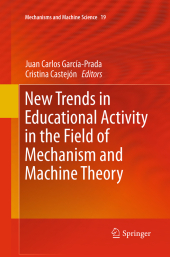 Neuerscheinungen 2016Stand: 2020-02-01 |
Schnellsuche
ISBN/Stichwort/Autor
|
Herderstraße 10
10625 Berlin
Tel.: 030 315 714 16
Fax 030 315 714 14
info@buchspektrum.de |

Cristina Castejón, Juan Carlos García-Prada
(Beteiligte)
New Trends in Educational Activity in the Field of Mechanism and Machine Theory
Herausgegeben von García-Prada, Juan Carlos; Castejón, Cristina
Softcover reprint of the original 1st ed. 2014. 2016. xii, 310 S. 142 SW-Abb. 235 mm
Verlag/Jahr: SPRINGER, BERLIN; SPRINGER INTERNATIONAL PUBLISHING 2016
ISBN: 3-319-37570-9 (3319375709)
Neue ISBN: 978-3-319-37570-0 (9783319375700)
Preis und Lieferzeit: Bitte klicken
The First International Symposium on the Education in Mechanism and Machine Science (ISEMMS 2013) aimed to create a stable platform for the interchange of experience among researches of mechanism and machine science.
Topics treated include contributions on subjects such as new trends and experiences in mechanical engineering education; mechanism and machine science in mechanical engineering curricula; MMS in engineering programs, such as, for example, methodology, virtual labs and new laws.
All papers have been rigorously reviewed and represent the state of the art in their field.
Introduction.- Preface.- Part I. Mechanism and machine science in the mechanical engineer curricula.- Historical evolution of the figure of engineers and mission for their formation, by M. Ceccarelli and R. Bragastini.- Toward a curriculum in mechatronics: two experiences in Italy and Spain, by F. Bonsignorio, L. Bruzzone, and P. Fanghella.- Mechanical Engineering at a Distance: a Review, by M. Artés and J. López.- Basic projects of knowledge integration in the bachelors´ degree in Industrial Technology, by S. Cardona Foix, L. Jordi Nebot, R. Pàmies-Vilà and P. Català Calderon.- Content and Realization of Mechanism Theory at RWTH Aachen University, by S. Kurtenbach, T. Mannheim, M. Hüsing and B. Corves.- Integration processes in engineering education. V. V. Kuzlyakina.- Part II. Mechanism and machine science in the engineer program: methodology.- Learning through competitive environments. Use of Robotic Simulation Environments combined with economic considerations, by J. L. Su¤er Martinez and F. J. Rubio.- Service-Learning Projects in Engineering Colleges, by J. M. García-Alonso, E. Soriano, I. García-Vicario, H. Rubio.- The Modern facilities and technologies of the teaching the course to theories mechanism and machines, by V. V. Kuzlyakina.- An example on inquiry-based learning for undergraduate Mechanical Vibrations, by J.M. Chicharro, A.L. Morales, A.J. Nieto and P. Pintado.- Application of techniques based on reliability for the improvement of the teaching of mechanisms in industrial design, by J. García Sanz-Calcedo, D. Rodríguez-Salgado I. Cambero, and J.M. Herrera.- Part III. Mechanism and machine science in the engineer program: applications and research.- Optomechatronics applications of the theory of mechanisms with active student involvement in research, by V.F. Duma, A. Schitea, M. Tuef, O. Cira, C. Mnerie, Gh. Hutiu, D. Demian and I. Kaposta.- Teaching Shaft Balancing as a Parameter estimation Problem, by J. Aginaga, X. Iriarte and J. Ros.- Paradox in the Mechanisms Science, by K.S. Ivanov and K. Jilisbaeva.- Modern view on ´History of Science´ teaching in technical universities, by A. Evgrafov, A. Khisamov and O. Egorova.- Multi-disciplinary optomechatronics student included research with applications in biomedical imaging, by V. F. Duma, M. L. Negrutiu, C. Sinescu, I. Voiculescu, E. Miutescu, A. Burlea, M. Vlascici and A. Gh. Podoleanu.- Analysis of dynamic systems using Bond Graph and SIMULINK, by J. A. Calvo, C. µlvarez-Caldas, J. L. San Román.- Teaching machine tools operation in virtual laboratories of Engineering Faculties, by M.J. Martín, F. Martín, C. Bermudo and L. Sevilla.- Virtual Laboratory Works on TMM, by V.B. Tarabarin, Z.I. Tarabarina, and A.G. Feygina.- Interactive Application for Technical Drawing Learning, by C. µlvarez-Caldas, J.A. Calvo, A. Quesada and J.L. San Román.- Part IV. Mechanical Engineering education: new trends.- Comparison of Geometry Software for the Synthesis and Analysis in Mechanism Theory, by S. Kurtenbach, I. Prause, C. Weigel and B. Corves.- Kinematic Analysis of Planar Mechanisms by Means of Examples, by M. Urízar, O. Altuzarra, M. Diez, F.J. Campa and E. Macho.- Teaching Mechanism and Machine Theory with Geogebra, by X. Iriarte, J. Aginaga and J. Ros .- Enhancing Mechanism and Machine Science learning by creating virtual labs with ADAMS. J. L. Su¤er and J. Carballeira.- Using the think MOTION project resources for the teaching of Mechanism and Machine Theory, by V. Petuya, Ch. Pinto, J. Corral, E. Amezua and A. Hernández.- Modern view on ´History of Science´ teaching in technical universities, by A. Evgrafov, A. Khisamov and O. Egorova.- Part V Mechanical Engineering education: experiences.- The experience of the University of Oviedo in the Motostudent competition. A. Noriega, R. Fernández and J.L. Cortizo.- Application of an inter-university competition on the enhancement of Engineering Degrees, by A. Fernández del Rincón, A. de Juan, P. García, M


